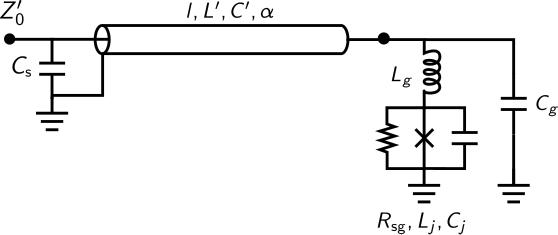TLmodel – Model for transmission line resonator¶
Module for the calculation of transmission line impedances
Most functions require a dictionary with specific elements regarding circuit parameters in it.:
params = {
'Z0': 64.611, # characteristic impedance of TL resonator (e.g. geometric and kinetic), in Ohm
'Cj': 1.77e-15, # Capacitance of the junction (RCSJ model) loading the TL resonator, in F
'Z0p': 50, # reference impedance of the input line, in Ohm
'Lg': 1.0432952403781536e-10, # geometric inductance of the junction leads loading the TL resonator, in H
'Rj': 1027.6618763504205, # Resistance of the junction (RCSJ model) loading the TL resonator, in Ohm
'n': 2.876042565429968, # refraction index for the TL resonator (v_ph = c / n)
'type': 'lambda/2', # expected type of TL resonator. Only used in Zincircuit_approx. Can be 'lambda/2', 'lambda/4'
'alpha': 0.0060728306929787035, # attenuation constant for the TL resonator. This mainly sets the internal losses, in 1/m
'Lj': 2.0916766016363636e-10, # Josephson inductance of the junction (RCSJ model) loading the TL resonator, in H
'Pin': -122, # input power at the coupler of the TL resonator, in dBm
'Cs': 2.657e-11, # shunt capacitance of the coupler, in F
'l': 0.006119 # length of the TL resonator, in m
}
The model calculated here is valid for a transmission line resonator coupled to the input line via a shunt capacitance Cs. At the far end, the TL resonator can be loaded by a RCSJ-type junction with an extra series inductor Lg and parallel capacitance Cg.

Circuit model used for TLmodel.py.¶
For more details see A ballistic graphene superconducting microwave circuit
Functions¶
-
stlabutils.TLmodel.FindParFromRes(params, w0, a, b, par='Lj', wws=None)[source]¶ Function to find value of a parameter to match a given resonance frequency
Finds approximate value of par to have an angular resonance frequency of w0. a,b is the bracketing interval. In our processing, the objective is to extract the load parameters from given resonance features, like the resonance frequency. Given w0, this function provides an initial estimate of these parameters to then perform the final fit such that the resonance frequency will start close to this value (for fit convergence).
- Parameters
params (dict) – Dictionary containing model parameters
w0 (float) – Desired angular resonance frequency
a (float) – Bottom of bracketing interval for the parameter
b (float) – Top of bracketing interval for the parameter
par (str, optional) – Key of the parameter in
paramsto be sweptwws (None or array, optional) – Angular frequency range to evaluate the circuit impedance at.
- Returns
par0 – Parameter value that satisfies desired resonance frequency for the given parameters
- Return type
-
stlabutils.TLmodel.Ix(x, omega, params)[source]¶ Current phasor at a given distance along the TL
Distance x counts from the load (at 0) to l (at input)
- Parameters
- Returns
Current phasor at a given distance along the TL
- Return type
-
stlabutils.TLmodel.S11(Zin, params)[source]¶ Exact expression of S11 for a given input impedance and parameters
-
stlabutils.TLmodel.S11theo(f, f0, kint, kext)[source]¶ Lorentzian absortion function
Approximate formula for a Series RLC circuit capacitively coupled on one side to a transmission line. The frequencies can be either angular or ‘real’ ones, as long as all of them have the same type.
-
stlabutils.TLmodel.Vin(omega, params)[source]¶ Voltage phasor at the input
If Pin is in params, it is used to calculate the actual amplitudes. If not, we assume an amplitude of 1V for the incoming wave.
-
stlabutils.TLmodel.Vj(omega, params)[source]¶ Voltage at the far end of the TL across a Josephson junction (RCSJ)
If there is a Lj and Cg in params, returns the voltage accross the junction (complex). Else, just the load voltage
-
stlabutils.TLmodel.Vx(x, omega, params)[source]¶ Voltage phasor at a given distance along the TL
Distance x counts from the load (at 0) to l (at input)
- Parameters
- Returns
result – Voltage phasor at a given distance along the TL
- Return type
-
stlabutils.TLmodel.ZTL(Z0, Zl, gammal)[source]¶ Impedance of a general terminated transmission line
Calculates the input impedance of a termniated transmission line with a given load impedance

-
stlabutils.TLmodel.Zcoup(omega, params)[source]¶ Impedance of a general capacitor
Here used for the shunt capacitor (coupler) at the start of the TL
-
stlabutils.TLmodel.Zincircuit(omega, params)[source]¶ Analytical dalculation of input impedance of a TL resonator with a shunt capacitor
Is only valid for a shunt coupler and depends on the definition of
Zload().Zload()is the impedance of the load on the far end of the TL resonator (opposite the coupler). Examples can be an open/short/junction end of the transmission line resonator. This is an analytical calculation using transmission line formulas (from Pozar). There are no lumped element approximations or equivalents involved.
-
stlabutils.TLmodel.Zincircuit_approx(omega, params)[source]¶ Lumped equivalent calculation of input impedance of a TL resonator with a shunt capacitor
Is only valid for a shunt coupler and assumes the load impedance is
params['Lg']. This is a lumped equivalent calculation of the TL resonator with either an open or a short end.
-
stlabutils.TLmodel.Zload(omega, params)[source]¶ Impedance of a load at the far end of the TL resonator
Currently includes the possiblitity for an RCSJ and a capacitor as load
-
stlabutils.TLmodel.Zx(x, omega, params)[source]¶ Impedance at a given distance along the TL
Distance x counts from the load (at 0) to l (at input)
- Parameters
- Returns
result – Impedance at a given distance along the TL
- Return type
-
stlabutils.TLmodel.f0(params, ffs=None)[source]¶ Finds the approximate resonance frequency in Hz from a generic circuit impedance
This is an approximation which can then be used to a fitting function as starting value